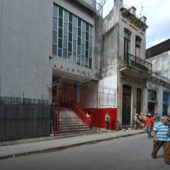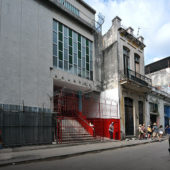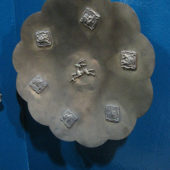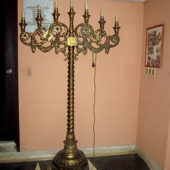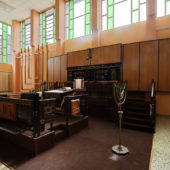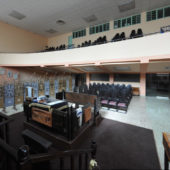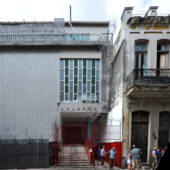This unassuming, almost unnoticeable building on a crowded, narrow street in the Old Havana district is the city’s Orthodox synagogue.
Jews arrived in Cuba shortly after the expulsion of Jews from Spain in 1492. Popular lore states that three Jews came with Columbus: Luis de Torres on the Santa Maria, Juan de Cabrera on La Pinta and Rodrigo de Triana on La Nina. All three were Marranos, forced Jewish converts to Catholicism. In spite of their practicing the Catholic faith, the hand of the inquisition still reached for them. The first trial of the Inquisition in Havana was against a Jew, Francisco Gomez de Leon, executed in Cartagena, after, of course, confiscating his large fortune, which without doubt was the cause of his persecution.
During the 16th and 17th centuries, many Jews immigrated to Cuba from Brazil, having been persecuted under the Portuguese. The new Jewish immigrants founded trade in Cuba and by the 18th century, Cuban Jewish trade routes included Amsterdam and Hamburg. However, Jews were harassed and many Jews assimilated into Cuban society. At the end of the 1800s, Jews from the Dutch Antilles settled in Cuba. They supported Jose Marti, who freed Cuba from Spanish colonial rule in 1898. After the Spanish-American War, many American Jewish war veterans moved to Cuba and founded a congregation in Havana in 1904. Cuban Jews were involved in all aspects of society and trade. Jews were instrumental in the sugar cane business; they transported sugar cane from Madeira to Brazil and then on to the Antilles. Jews were the first people to use protective cloth to protect tobacco plants from the extremes of weather. This is still being done today to produce the finest quality of tobacco in the world. Many Jewish traders pursuing business in the New World set up outposts on Cuba.
After the Spanish-American War, the Jewish presence became permanent. American Ashkenazi Jews (born in Europe) immigrated to Cuba to work for U.S.-owned plantations and businesses. In 1906, eleven founded the United Hebrew Congregation, a Reform synagogue, that conducted its services in English. This was officially considered to be the beginning of the Jewish community in Cuba. A large number of Jews immigrated to Cuba in 1910 and 1920, including Sephardic Jews from Turkey, as a stop-over point on their way to the United States. However, there was a quota for immigrants allowed into the United States, so many stayed in Cuba, due to the fact that there wasn’t much anti-Semitism. Many of these new immigrants prospered in Cuban’s garment trade. By 1924, 24,000 Jews lived in Cuba. In the 1930s, a central Jewish committee was established as a base for all of the Jewish groups.
At the time of the Castro lead Socialist Revolution in 1959, there were approximately15,000 Jews in Cuba. About 75% of the Jewish population lives in Havana. Jewish people tend to be merchants and entrepreneurial, therefore socialism was not attractive to them and approximately 94% of Cuba’s Jewish population fled after the Revolution. There are less than 2,000 Jews remaining in Cuba, most living in Havana. Jews and Christians were persecuted after the Revolution and had restricted access to jobs and universities. However, they were still allowed to practice their religion, distribute kosher food and to receive donations from other nations. In 1973, Cuba severed diplomatic relations with Israel and is considered to be one of Israel’s worst enemies. In the late 1960s a number of Jews were sent to forced labor camps, having been accused as political dissenters, religious peoples, gays and/or exit applicants. Jewish activists were constantly under surveillance. Predictably, Jewish life went more “underground,” but has still survived. In the 1970s , a synagogue and school in Havana were both closed. In the 1980s, a further synagogue was closed. Throughout the 1980s, even Havana’s largest synagogue, the Patronato, had difficulty forming a minyan (a quorum of ten men required for a religious service). Cuban Jewry faced assimilation and its elders were concerned about the community’s future.
In 1991 a law was passed permitting members of the Communist party to have religious affiliations. This was a significant step in rejuvenating Judaism in Cuba. Due to Cuba’s economic problems, its Jewish community is among the poorest in the world. The JDC (American Joint Distribution Committee has worked to help build up Cuban Jewry and to aid the people on a social level. As of 2011, there are three synagogues in Havana, which survived the Revolution, to serve the 1,000 Jews in the city today: El Patronata (Beth Shalom), Centro Sefardi, and Adath Israel de Cuba. El Patronato is a Conservative synagogue, Centro Sefardi practices the Sephardic rite and Adath Israel is Orthodox.
After WWI, there was only the Ashkenazi synagogue in Havana, the United Hebrew Congregation. Religiously, it was very liberal with a wealthy, English-speaking membership. This was not a comfortable place for the Yiddish-speaking immigrants from Eastern Europe to worship. In 1923, a Lithuanian immigrant, Ben Zion Sofer, started a minyan in his apartment at Calle Paola No. 17. By 1925, the minyan developed into Congregación Adath Israel, located on the second floor of Calle Jesús María 103. The shul was basic, but served the congregants. The majority of Ashkenazi immigrants were not strictly observant; therefore, Adath Israel was only nominally Orthodox. The prayer services were traditional.
Eventually it was decided to build the new synagogue in Vedado, the heart of the Jewish Quarter of Habana Vieja (old Havana). Architect, Oscar Baisman, and construction engineer, Jacinto Feh Leonard, constructed a modern sanctuary with seating for six hundred people, a chapel and a reception hall. The cornerstone for the $100,000 synagogue was laid in April of 1956 and it was completed on October 9, 1959. Monies were recently been granted to renovate the area, which included the synagogue. The Havana Restoration Commission worked with Jorge Herrera on plans regarding the synagogue restoration, which included full restoration of the sanctuary and an innovative frame for the roof to be used for celebrating Sukkot. Most of the money for the synagogue restoration was donated by wealthy businessmen from Panama and Venezuela. Currently, there are 400 members in the congregation. The congregation has a program to supply vitamins, some medications and toiletries to members who are in need and live nearby.
The exterior of Adath Israel is a modern concrete structure with a panel of vertical windows offset next to each other. Underneath the windows is a portico supported by cement columns. Cement steps lead up to the entrance. Tall, red fencing with barbed wire runs across the front of the property. Inside the stunning prayer room, peach walls are illuminated by offset, clear, blue and green windows. Dark gray carpeting is laid in the front section of the prayer room, demarcating the bimah. The large tivah (reader’s desk) is situated in the center of the room, sitting on the front section of the gray carpeting. It is surrounded by dark wood panels, beautifully carved and decorated with gold Stars-of-David and intricately carved light wood panels. Open at either side, the dark wood tivah sits inside, covered by a dark throw. Behind the tivah is the raised platform, with steps on either side. A dark, turned wood balustrade runs across the front of the platform and along the sides of the staircases. The back wall is an elegant backdrop for the Aron Kodesh. Peach walls with the offset windows up above, feature vertical wood panels above the platform. The center wood panel protrudes and from it drops the dark Torah curtain, embroidered in gold, behind which are stored the Torah scrolls. On the floor, to the right of the tivah, stands a tall menorah. Along the right wall is a spectacular grill in alternate gold and light blue panels. Upstairs, along the back, is the women’s gallery, separated from the main sanctuary by a low peach wall. Specially built black iron chairs whose backs form the shape of a menorah with pink cushions sit on gray speckled linoleum flooring.

